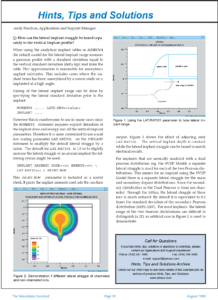HINTS & TIPS
Q: How can the lateral implant straggle be tuned separately to the vertical implant profile?
A: When using the analytical implant tables in ATHENA the default model for the lateral implant range assumes a gaussian profile with a standard deviation equal to the vertical standard deviation (delta Rp) read from the table. This approximation is reasonable for amorphous implant substrates. This includes cases where the implant beam has been amorphised by a screen oxide or is implanted at a high angle.
Tuning of the lateral implant range can be done by specifying the lateral standard deviation prior to the implant:
MOMENTS ...... LSTD.DEV=<value>
IMPLANT ......
However this is cumbersome to use in many cases since the MOMENTS statement requires explicit definition of the implant dose and energy and all the vertical implant parameters. Therefore it is more convenient to use a unit less scaling parameter LAT.RATIO1 on the IMPLANT statement to multiply the default lateral straggle by a factor. The default for LAT.RATIO1 is 1.0 so to slightly increase the lateral straggle of an arsenic implant the following syntax might be used:
IMPLANT ARSENIC DOSE=<v> ENERGY=<v> LAT.RATIO1=1.2 PRINT.MOM
This PRINT.MOM parameter is included as a useful check. It prints the implant moments used into the run-time output. Figure 1 shows the effect of adjusting only LAT.RATIO1. The vertical implant depth is constant while the lateral implant straggle can be tuned to match electrical results.



